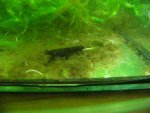Azhael
Site Contributor
- Joined
- May 7, 2007
- Messages
- 6,644
- Reaction score
- 121
- Points
- 0
- Location
- Burgos
- Country
- Spain
- Display Name
- Rodrigo
This season i decided i would raise my H.orientalis and C.pyrrhogaster juveniles aquatic from the very beginning, with no terrestrial period, and already i´m very pleased with the decission. After reading about Tudor´s experience doing this i was confident it could work but i was still rather afraid to try it because of past experiences.
Now, it must be said that my experience so far only includes one individual I have several larvae of each species that to my unending delight are growing big and juvenile-like despite not showing signs of inmediate metamorphosis. Funnily enough, the one metamorphosed juvenile from this season that i have so far morphed tiny and underdeveloped (its larvals siblings are substantially bigger and bulkier). Despite this, it only tried to climb the walls and avoid the water for about a week, then on its own accord started to submerge and hunt for food underwater. For the last three weeks or so it´s been spending a lot of time walking along the bottom then resting near the surface for a while. I haven´t had to tweezer feed it since that first week. Right now it´s exactly 3cm long, and it morphed at only 2,5 cm.
I have several larvae of each species that to my unending delight are growing big and juvenile-like despite not showing signs of inmediate metamorphosis. Funnily enough, the one metamorphosed juvenile from this season that i have so far morphed tiny and underdeveloped (its larvals siblings are substantially bigger and bulkier). Despite this, it only tried to climb the walls and avoid the water for about a week, then on its own accord started to submerge and hunt for food underwater. For the last three weeks or so it´s been spending a lot of time walking along the bottom then resting near the surface for a while. I haven´t had to tweezer feed it since that first week. Right now it´s exactly 3cm long, and it morphed at only 2,5 cm.
I did not expect such a tiny little metamorph to adapt so well, and i´m really chuffed with the results. I´m confident the rest of the larvae will do just as well after they morph.
If things continue to go well i´m going to need to update the CC article xD
I´ll leave you with a bad picture of the little fella hunting enchytraeus underwater. I love you little, independent newt!
Now, it must be said that my experience so far only includes one individual
I did not expect such a tiny little metamorph to adapt so well, and i´m really chuffed with the results. I´m confident the rest of the larvae will do just as well after they morph.
If things continue to go well i´m going to need to update the CC article xD
I´ll leave you with a bad picture of the little fella hunting enchytraeus underwater. I love you little, independent newt!


 Asian Newt Group
Asian Newt Group